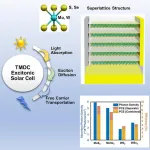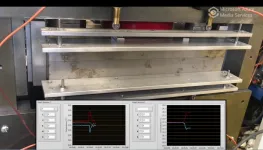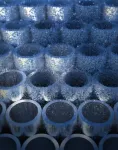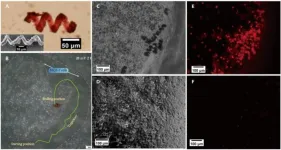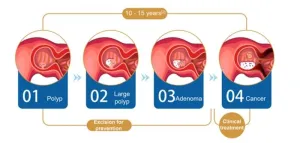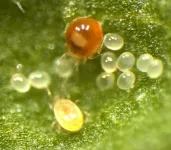(Press-News.org) When it comes to supplying energy for space exploration and settlements, commonly available solar cells made of silicon or gallium arsenide are still too heavy to be feasibly transported by rocket. To address this challenge, a wide variety of lightweight alternatives are being explored, including solar cells made of a thin layer of molybdenum selenide, which fall into the broader category of 2D transition metal dichalcogenide (2D TMDC) solar cells. Publishing June 6 in the inaugural issue of the journal Device, researchers propose a device design that can take the efficiencies of 2D TMDC devices from 5%, as has already been demonstrated, to 12%.
“I think people are slowly coming to the realization that 2D TMDCs are excellent photovoltaic materials, though not for terrestrial applications, but for applications that are mobile—more flexible, like space-based applications,” says lead author and Device advisory board member Deep Jariwala of University of Pennsylvania. “The weight of 2D TMDC solar cells is 100 times less than silicon or gallium arsenide solar cells, so suddenly these cells become a very appealing technology.”
While 2D TMDC solar cells are not as efficient as silicon solar cells, they produce more electricity per weight, a property known as “specific power.” This is because a layer that is just 3–5 nanometers thick—or over a thousand times thinner than a human hair—absorbs an amount of sunlight comparable to commercially available solar cells. Their extreme thinness is what earns them the label of “2D”—they are considered “flat” because they are only a few atoms thick.
“High specific power is actually one of the greatest goals of any space-based light harvesting or energy harvesting technology,” says Jariwala. “This is not just important for satellites or space stations but also if you want real utility-scaled solar power in space.”
“The number of solar cells you would have to ship up is so large that no space vehicles currently can take those kinds of materials up there in an economically viable way. So, really the solution is that you double up on lighter weight cells, which give you much more specific power.”
The full potential of 2D TMDC solar cells has not yet been fully realized, so Jariwala and his team have sought to raise the efficiency of the cells even further. Typically, the performance of this type of solar cell is optimized through the fabrication of a series of test devices, but Jariwala’s team believes it is important to do so through modeling it computationally.
Additionally, the team thinks that to truly push the limits of efficiency, it is essential to properly account for one of the device’s defining—and challenging to model— features: excitons.
Excitons are produced when the solar cell absorbs sunlight, and their dominant presence is the reason why a 2D TMDC solar cell has such high solar absorption. Electricity is produced by the solar cell when the positively and negatively charged components of an exciton are funneled off to separate electrodes.
By modeling the solar cells in this way, the team was able to devise a design with double the efficiency compared to what has already been demonstrated experimentally.
“The unique part about this device is its superlattice structure, which essentially means there are alternating layers of 2D TMDC separated by a spacer or non-semiconductor layer,” says Jariwala. “Spacing out the layers allows you to bounce light many, many times within the cell structure, even when the cell structure is extremely thin.”
“We were not expecting cells that are so thin to see a 12% value. Given that the current efficiencies are less than 5%, my hope is that in the next 4 to 5 years people can actually demonstrate cells that are 10% and upwards in efficiency.”
Jariwala says the next step is to think about how to achieve large, wafer-scale production for the proposed design. “Right now, we are assembling these superlattices by transferring individual materials one on top of the other, like sheets of paper. It’s as if you’re tearing them off from one book, and then pasting them together like a stack of sticky notes,” says Jariwala. “We need a way to grow these materials directly one on top of the other.”
###
This work was supported by the Asian Office of Aerospace Research and Development (AOARD), the Air Force Office of Scientific Research (AFOSR), the Office of Naval Research, University Research Foundation at Penn, the Alfred P. Sloan Foundation, and the Center for Undergraduate Research Fellowships (CURF) at U. Penn.
Device, Hu et al. “How Good Can 2D Excitonic Solar Cells Be?” https://cell.com/device/fulltext/S2666-9986(23)00003-0
Device (@Device_CP), is a physical science journal from Cell Press along with Chem, Joule, and Matter. Device aims to be the breakthrough journal to support device- and application-oriented research from all disciplines, including applied physics, applied materials, nanotechnology, robotics, energy research, chemistry, and biotechnology under a single title that focuses on the integration of these diverse disciplines in the creation of the cutting-edge technology of tomorrow. Visit http://www.cell.com/device/home. To receive Cell Press media alerts, contact press@cell.com.
END
About The Study: In this survey of clinician-researchers who received career development grants from the National Institutes of Health, there were concerning rates of sexual harassment, cyber incivility, and negative perceptions of climate, disproportionately affecting minoritized groups and affecting mental health. Ongoing efforts to transform culture are necessary.
Authors: Reshma Jagsi, M.D., D.Phil., of Emory University in Atlanta, is the corresponding author.
To access the embargoed ...
BOSTON—Currently there are no contraceptives capable of producing permanent sterilization in companion animals. Spaying, the surgical removal of the ovaries and uterus, is the most widely used strategy to control unwanted reproduction in female cats.
For the first time, researchers at Massachusetts General Hospital (MGH), a founding member of Mass General Brigham (MGB), and their collaborators have demonstrated that a single dose of anti-Müllerian hormone (AMH) gene therapy can induce long-term contraception in the domestic cat, potentially providing a safe and effective alternative to surgical spaying. The research ...
About The Study: In this network meta-analysis of 10 observational studies including 3,083 patients with breast cancer who received surgical treatment, expert panel–based and computer-based aesthetic outcome evaluation consistently scored lower than patient-perceived outcomes. Standardization and supplementation of expert panel and software aesthetic outcome tools with racially, ethnically, and culturally inclusive patient-reported outcome measures is needed to improve clinical evaluation of the journey of patients with breast cancer and to prioritize components ...
About The Study: This randomized clinical trial found that, although the peer health coaching program did not significantly decrease systolic blood pressure, participants who received the intervention reported better mental health-related quality of life compared with the control group. The results suggest that a peer-support model that is integrated into primary care can create opportunities for well-being improvements beyond blood pressure control.
Authors: Karin M. Nelson, M.D., M.S.H.S., of the Veterans Affairs Puget Sound Health Care System in Seattle, is the corresponding author.
To access ...
College Park, Md. — Air conditioning, refrigeration, and other cooling technologies account for more than 20 percent of today’s global energy consumption, while the refrigerants they use have a global warming potential thousands of times greater than carbon dioxide. In a recent study in the journal Science, a team led by Maryland Engineering Professors Ichiro Takeuchi, Reinhard Radermacher, and Yunho Hwang introduced a high-performance elastocaloric cooling system that could represent the next generation of cooling devices.
Takeuchi calls ...
Patients would be more willing to enter medication-assisted treatment for opioid use disorder if existing stigmas were reduced and more accessible payment support was readily available, a West Virginia University study finds.
Adam Baus, director of the Office of Health Services Research, and his team gained insight from patients on what helped or hindered medication-assisted treatment, or MAT, to support recovery.
“Little research attention has been given to learning directly from those in medication-assisted treatment for opioid use disorder,” said Baus, also a research assistant professor with the WVU School of Public Health ...
Researchers at Kyoto University, Okinawa Institute of Science and Technology Graduate University (OIST), and Photron Limited in Japan have developed the world’s fastest camera capable of detecting fluorescence from single molecules. They describe the technology and examples of its power in two articles published in the same issue of the Journal of Cell Biology.
“Our work with this camera will help scientists understand how cancer spreads and help develop new drugs for treating cancer,” says bio-imaging expert Takahiro Fujiwara, who led the research at the Institute for Integrated Cell-Material Sciences (iCeMS).
Single fluorescent-molecule ...
The limited ability of microrobots to assist drugs in entering cells hinders their therapeutic efficacy. To address this, the cancer-targeting molecule folic acid (FA) was introduced to microrobots to promote drug uptake by cancer cells via receptor-ligand-mediated endocytosis. This results in a drug delivery system that can locate lesion areas with magnetic fields and deliver loaded drugs into the cytoplasm through endocytosis.
The team published their findings in the Journal of Cyborg and Bionic Systems ...
Recently, BGI Genomics' COLOTECT™ 1.0 DNA Methylation Detection Kit for Human SDC2, ADHFE1, and PPP2R5C Genes (Real-Time PCR), Sample Pretreatment Kit for Methylation Detection, DNA Isolation Kit, Stool Sample Collection Kit have received market authorization from Malaysia’s Medical Device Authority (hereinafter referred to as MDA).
With this certification, COLOTECT™ 1.0 is now available in over six countries/regions and markets that recognize these certificates. COLOTECT™ 1.0 is eligible for EU market entry, ...
Several animal species display brood care, a phenomenon where ‘caring’ parents provide their offspring with food and protection against predators. However, there are many others that prefer not to do this, and instead sneak in their eggs with those of other ‘caring’ species to avail free brood care. This behavior, called brood parasitism, is observed in fishes, frogs, and birds, with the most famous example being that of the cuckoo. Such brood parasitism has now also been observed in the insect world in tiny organisms called mites. Generally, brood parasitism takes a toll on the host and benefits the parasite. However, ...
